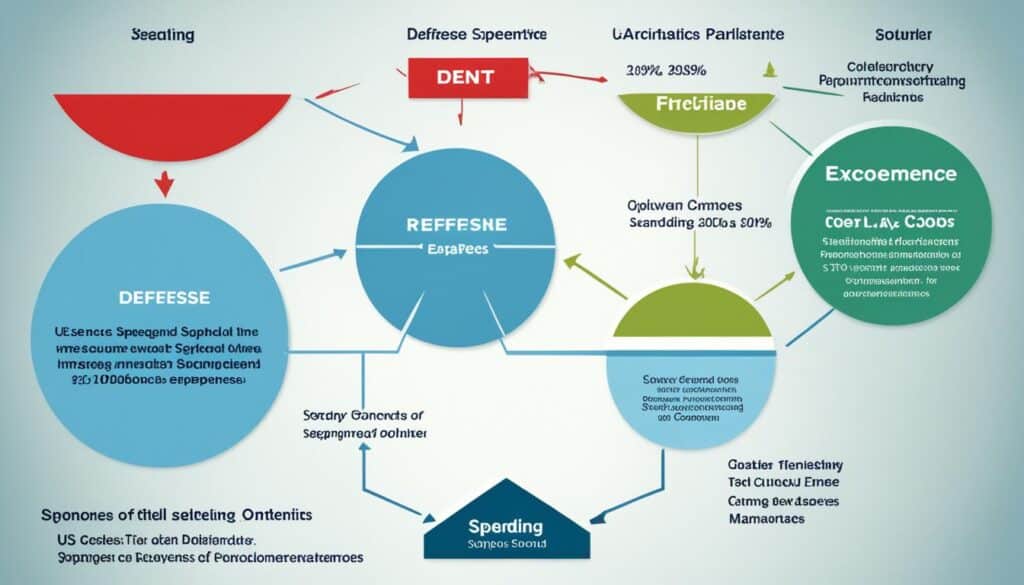Defense spending is key after military conflicts. Over the years, violent fights around the world increased. The count of war-torn countries rose from 32 in 2019 to 59 by 2022. The U.S., a big global player, spends a lot on defense. In 2023, more than half of the U.S. federal government’s goods and services money went to defense.
While defense spending compared to the GDP has dropped since the peak seen during actions in Afghanistan and Iraq in 2010, the U.S. still spends a lot. It is said to spend more than any other country, about half of all money spent on military around the world. Looking at the economic effects of defense spending is crucial.
Key Takeaways:
- Defense spending is crucial in the aftermath of military conflicts.
- The United States has a significant defense budget that influences its economy.
- National defense spending accounted for more than half of all federal government purchases in 2023.
- While defense spending as a percentage of GDP has decreased, the United States still spends more on defense than any other country.
- Understanding the economic implications of defense spending is essential for analyzing the aftermath of military conflicts.
The Breakdown of US Defense Spending
The US government puts its money into different parts of defense to keep the country safe. Knowing how this money is used helps us see what areas the country values most. It also shows where investments are made toward defense.
Compensation: Supporting Military Personnel and Civilian Defense Workers
Nearly two-fifths of defense spending goes to paying people. This means salaries for military and civilian workers. Offering good pay and benefits helps the country keep skilled workers.
Investment in Defense: Strengthening Military Capabilities
A quarter of the budget is spent on buying and improving things like tanks and planes. This includes research and development for new technology. It’s all about making the military stronger and more advanced.
Intermediate Goods and Services: Supporting Operational Flexibility
Part of the budget goes to services that help the military be more flexible. This can include work done by private companies. They provide special services to meet the army’s needs.
Supplies and Equipment for Current Operations: Ensuring Readiness
Some money is used to buy supplies and equipment for the military’s daily tasks. This means keeping things in working order and supporting operations. It’s vital for the military to always be ready.
The Increasing Threat Landscape: Potential Impact on Defense Investment
As threats change and grow, more money might be needed for defense. This could mean spending more on modern equipment and new technology. The goal is to be prepared for any danger.
For a detailed look at US defense spending, check out this table:
| Category | Percentage of Defense Spending |
|---|---|
| Compensation | 39% |
| Investment in Defense | 25% |
| Intermediate Goods and Services | 18% |
| Supplies and Equipment for Current Operations | 13% |
| Other Expenditure Categories | 5% |
This table helps us see where defense money is spent. It’s key for policy makers and experts to make smart choices. It ensures the country is safe and the military can do its job well.
Comparison and Context of US Defense Spending
When looking at defense spending, the US stands out. It spends more on its military than any other country. This is because the US allocates a big part of its budget to defense.
The United States spends roughly half of the world’s total military budget. Even China, with the second-largest defense budget, spends much less. It shows the US’s big effort in defense compared to other nations.
Comparing defense spending is not straightforward. This is because each country measures it differently. But, the US is always seen as a leader in military investment. Whether looking at the money spent or its share of the economy, the US leads in defense spending.
Defense Spending Comparison by Country
Let’s compare the US defense budget with other key countries:
| Country | Defense Budget |
|---|---|
| United States | $defense budget |
| China | $defense budget |
| India | $defense budget |
| Saudi Arabia | $defense budget |
| Russia | $defense budget |
From the table, we see the US spends a lot more than others. It clearly shows the US’s commitment to military might and global role.
It’s important to understand defense spending’s context. The US’s strong investment in defense helps not only its safety but also global security. This spending maintains a balance worldwide.
Conclusion
Defense spending is vital for the United States, especially during military conflicts. It uses a big part of the budget and influences many economic sectors. As conflicts grow globally, it’s key to review how much is spent on defense and its economic results.
Studying defense spending and its effect on the US economy helps us see what happens after wars. Even though the government sees it as important, balancing military needs with saving money is tough. Finding this sweet spot is crucial yet challenging.
Looking closely at defense spending teaches policymakers and experts a great deal. They get to understand how wars affect the US economy. They also see the US’s big role in world military spending. This perspective is crucial for making smart economic choices during conflicts.
FAQ
What is defense spending?
Why is defense spending important?
How does the United States allocate its defense budget?
How does US defense spending compare to other countries?
How does defense spending impact the US economy?
How does defense spending change in the aftermath of military conflicts?
Source Links
- https://www.pgpf.org/budget-basics/budget-explainer-national-defense
- https://www2.deloitte.com/us/en/insights/economy/spotlight/the-return-of-us-defense-spending.html
- https://www.rand.org/content/dam/rand/pubs/research_reports/RRA700/RRA739-2/RAND_RRA739-2.pdf
Disclaimer
All information on this website is of a general nature. The information is not adapted to conditions that are specific to your person or entity. The information provided can not be considered as personal, professional or legal advice or investment advice to the user.
This website and all information is intended for educational purposes only and does not give financial advice. Signal Mastermind Signals is not a service to provide legal and financial advice; any information provided here is only the personal opinion of the author (not advice or financial advice in any sense, and in the sense of any act, ordinance or law of any country) and must not be used for financial activities. Signal Mastermind Signals does not offer, operate or provide financial, brokerage, commercial or investment services and is not a financial advisor. Rather, Signal Mastermind Signals is an educational site and a platform for exchanging Forex information. Whenever information is disclosed, whether express or implied, about profit or revenue, it is not a guarantee. No method or trading system ensures that it will generate a profit, so always remember that trade can lead to a loss. Trading responsibility, whether resulting in profits or losses, is yours and you must agree not to hold Signal Mastermind Signals or other information providers that are responsible in any way whatsoever. The use of the system means that the user accepts Disclaimer and Terms of Use.
Signal Mastermind Signals is not represented as a registered investment consultant or brokerage dealer nor offers to buy or sell any of the financial instruments mentioned in the service offered.
While Signal Mastermind Signals believes that the content provided is accurate, there are no explicit or implied warranties of accuracy. The information provided is believed to be reliable; Signal Mastermind Signals does not guarantee the accuracy or completeness of the information provided. Third parties refer to Signal Mastermind Signals to provide technology and information if a third party fails, and then there is a risk that the information may be delayed or not delivered at all.
All information and comments contained on this website, including but not limited to, opinions, analyzes, news, prices, research, and general, do not constitute investment advice or an invitation to buy or sell any type of instrument. Signal Mastermind Signals assumes no responsibility for any loss or damage that may result, directly or indirectly, from the use or dependence on such information.
All information contained on this web site is a personal opinion or belief of the author. None of these data is a recommendation or financial advice in any sense, also within the meaning of any commercial act or law. Writers, publishers and affiliates of Signal Mastermind Signals are not responsible for your trading in any way.
The information and opinions contained in the site are provided for information only and for educational reasons, should never be considered as direct or indirect advice to open a trading account and / or invest money in Forex trading with any Forex company . Signal Mastermind Signals assumes no responsibility for any decisions taken by the user to create a merchant account with any of the brokers listed on this website. Anyone who decides to set up a trading account or use the services, free of charge or paid, to any of the Broker companies mentioned on this website, bears full responsibility for their actions.
Any institution that offers a service and is listed on this website, including forex brokers, financial companies and other institutions, is present only for informational purposes. All ratings, ratings, banners, reviews, or other information found for any of the above-mentioned institutions are provided in a strictly objective manner and according to the best possible reflection of the materials on the official website of the company.
Forex/CFD trading is potentially high risk and may not be suitable for all investors. The high level of leverage can work both for and against traders. Before each Forex/CFD investment, you should carefully consider your goals, past experience and risk level. The opinions and data contained on this site should not be considered as suggestions or advice for the sale or purchase of currency or other instruments. Past results do not show or guarantee future results.
Neither Signal Mastermind Signals nor its affiliates ensure the accuracy of the content provided on this Site. You explicitly agree that viewing, visiting or using this website is at your own risk.




